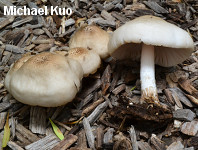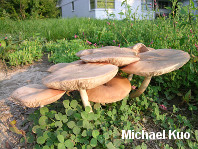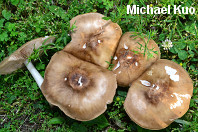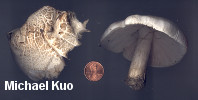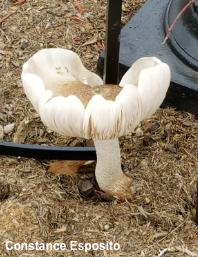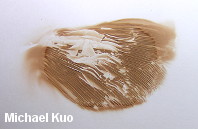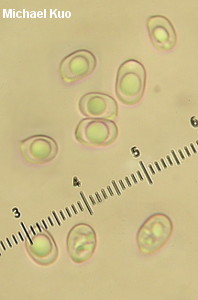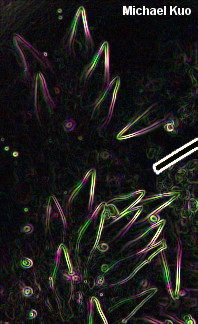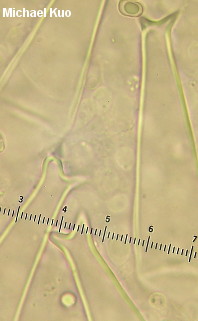| Major Groups > Gilled Mushrooms > Pink-Spored > Pluteus > Pluteus petasatus |

|
[ Basidiomycota > Agaricales > Pluteaceae > Pluteus . . . ] Pluteus petasatus by Michael Kuo, 19 March 2025 This mushroom can cause quite a little confusion. Its gills remain white for quite a long time (as compared to its close relative, Pluteus cervinus), and it is more likely to be found growing from woodchips, buried wood in urban areas (especially where trees have been taken out within a year or two), woody mulch, or sawdust, appearing terrestrial rather than popping out of a stump. However, the gills do eventually turn Pluteus-pink, and once they do, the same factors that were confusing at first become useful features for identification—coupled with the fact that the cap is usually (but not always!) whitish to very pale brown, with fine brown scales over the center. For more certain identification, however, microscopic features should be checked; Pluteus petasatus features abundant, fusiform "intermediate cystidia" that have not yet developed the apical prongs of mature pleurocystidia (see the illustrations). Thanks to Constance Esposito and Michelle Lierl for collecting, documenting, and preserving Pluteus petasatus for study; their collections are deposited in The Herbarium of Michael Kuo. Description: Ecology: Saprobic on the deadwood of hardwoods, but frequently found in woodchips, woody mulch, sawdust piles, and the like; often appearing in urban areas, especially where trees have been removed within one or two years; somteimes growing from buried wood and appearing terrestrial; growing alone, gregariously, or, more often, in loose clusters; late spring through fall, or over winter in warm climates; originally described from Sweden (Fries 1838) and neotypified from St. Petersburg, Russia by Justo et al. (2014); widely distributed in Europe and North America, and reported from Oceania. The illustrated and described collections are from Illinois, Indiana, and Georgia. Cap: 4–14 cm; convex at first, becoming broadly convex or nearly flat, with or without a shallow central bump; tacky when fresh but soon dry; bald when young, becoming finely scaly over the center; color variable—usually whitish or very pale brown, with a darker, browner center, but sometimes medium to dark brown overall; the margin not usually lined, but sometimes splitting radially in places by maturity. Gills: Free from the stem; close or crowded; short-gills frequent; white at first, and remaining so for quite a while—but eventually pink to brownish pink. Stem: 3.5–10 cm long; 1–2 cm thick; more or less equal, or with a slightly enlarged base; dry; bald or, toward the base, finely fibrillose or shaggy; whitish, discoloring brownish to brown below; basal mycelium white. Flesh: Firm and white throughout; unchanging when sliced. Odor: Not distinctive. Chemical Reactions:Chemical Reactions: KOH negative on cap surface. Spore Print: Brownish pink. Microscopic Features: Spores 5–8 x 3.5–6 µm; ellipsoid; smooth; hyaline and uniguttulate in KOH; inamyloid. Basidia subclavate; 4-sterigmate. Cheilocystidia clavate to sphaeropedunculate; thin-walled; hyaline in KOH. Pleurocystidia 50–85 x 10–25; lageniform, with a flared apex; smooth; thick-walled; developing 2–4 apical hooks. Intermediate cystidia usually abundant; fusiform to lageniform, without apical processes or with developing apical processes; smooth; hyaline in KOH. Pileipellis a cutis; elements 3–7.5 µm wide, smooth, hyaline to brown in KOH; clamp connections not found. REFERENCES: (E. M. Fries, 1838) C. -C. Gillet, 1876. (Kauffman, 1918; Singer, 1956; Smith, Smith & Weber, 1979; Arora, 1986; Vellinga, 1990; Phillips, 1991/2005; Banerjee & Sundberg, 1995; Bessette, Miller, Bessette & Miller, 1995; Breitenbach & Kränzlin, 1995; McNeil, 2006; Justo & Castro, 2007; Kuo, 2007; Bougher, 2009; Kibby et al., 2010; Justo et al., 2011a; Justo et al., 2011b; Buczacki et al., 2012; Justo et al., 2014; Kuo & Methven, 2014; Desjardin, Wood & Stevens, 2015; Siegel & Schwarz, 2016; Baroni, 2017; Heilmann-Clausen, 2018; Sturgeon, 2018; Læssøe & Petersen, 2019; Kibby, 2020; McKnight et al., 2021.) Herb. Kuo 06170205, 09280505, 10040501, 05281302, 06071304, 02221801, 06302401. This site contains no information about the edibility or toxicity of mushrooms. |
© MushroomExpert.Com |
|
Cite this page as: Kuo, M. (2025, March). Pluteus petasatus. Retrieved from the MushroomExpert.Com Web site: http://www.mushroomexpert.com/pluteus_petasatus.html |

